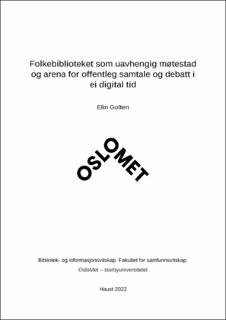Folkebiblioteket som uavhengig møtestad og arena for offentleg samtale og debatt i ei digital tid
Doctoral thesis, Peer reviewed
Published version
Permanent lenke
https://hdl.handle.net/11250/3037065Utgivelsesdato
2022Metadata
Vis full innførselSamlinger
Sammendrag
I avhandlinga blir det utforska korleis sentrale aktørar i to lokalsamfunn: bibliotekarar, bibliotekbrukarar, lokale politikarar og samarbeidspartar med biblioteket, definerer biblioteket som ein møtestad og ein institusjon som skal byggje opp under ei berekraftig lokal offentlegheit. Studien nyttar kvalitative intervju, og er ein samanliknande casestudie med to case, Fjell folkeboksamling og Voss bibliotek og konteksten av lokalsamfunna dei opererer i. Det blir nytta ulike teoretiske tilnærmingar for å studere biblioteket som møtestad; biblioteket som tredje stad (Oldenburg, 1999), offentleg rom (Lofland, 1998; Sennett, 2009), og høg- eller lågintensiv møtestad (Audunson, 2005b). Habermas (1962/1991) sin teori om offentlegheit belyser på same vis biblioteket som arena for samtale og debatt. I prosjektet finn ein at ulikskapar ved lokalsamfunn, til dømes knytt til demografi, historie og tradisjonar, utviklingsdynamikk, og nærleik til byen har innverknad på korleis biblioteket fungerer som lokal offentleg sfære. Funn indikerer at som arrangementsarena er folkebiblioteka særskilt nytta av eldre, kvinner og barn, medan ungdom og innvandrar er lite til stades. Tema og tidspunkt for arrangementa er avgjerande for kven som kjem. Arrangementa bidrar til den sosiale dimensjonen ved biblioteket, men hovudsakleg gjennom dei uformelle treffa mellom folk før og etter arrangementet, og i pausar undervegs. Dei fungerer delvis som tredje stader men er for organiserte til å samsvare med Oldenburg sin teori. Arrangementa ser ut til å vere vekslande lågintensive og høgintensive møtestader, definert av samansetnaden på deltakarar og kor nært tema er den einskilde sitt livsprosjekt. Offentlege rom blir av Sennett og Lofland definerte som urbane arenaer. I prosjektet finn ein at det er behov for denne typen møtestader også i meir rurale strok. Folkebiblioteka si rolle som debattarena er lite nytta i dei to folkebiblioteka, med få debattarrangement. Det blir avdekka potensielle utfordringar knytt til folkebiblioteka si rolle som uavhengige arenaer samstundes som dei er kommunale institusjonar, og når det gjeld kva rom folkebiblioteka har til å definere kva stemmer som får sleppe til. Når det gjeld å prioritere mellom oppgåver, er det like mange informantar som legg vekt på biblioteket som ein tradisjonell arena, som vektlegge både tradisjonell og sosial arena like mykje. Det er færre som meiner den sosiale arenaen bør prioriterast. Verdien av biblioteket blir sett i samanheng med både personleg og samfunnsmessig verdi. Biblioteket blir også tillagt verdi berre ved å vere der som ei moglegheit. Det blir sett fram behov for og ønske om at biblioteket må endre seg for framleis å ha verdi i ei digital tid.
The thesis explores how central actors in two local communities: librarians, library users, local politicians and library cooperating partners, define the library as a meeting place and as an institution contributing to a sustainable local public sphere. The study uses qualitative interviews, and is a comparative case study with two cases, Fjell public library and Voss public library, and the context of the local societies within which they operate. Different theoretical approaches are used to study the library as a meeting place; the library as a third place (Oldenburg, 1999), public realm (Lofland, 1998; Sennett, 2009), and high- or low-intensive meeting place (Audunson, 2005b). Habermas’ (1962/1991) theory on the public sphere is used to shed light on the library as an arena for conversations and debate. Findings show that differences in local communities, related to for example demographics, history and tradition, development dynamics, and proximity to urban settings, influence how the library functions as a local public sphere. Findings indicate that as an event venue the library is mostly used by the elderly, by women and by children. Youths and immigrants are less present. Topics and timing of the events are crucial for who turns up. The events contribute to the social dimension of the library, but mainly through the informal meetings before, after, and in breaks during the events. They function partly as third places but are too organized to fully correspond to Oldenburg’s theory. They seem to constitute alternating low-intensive and high-intensive meeting places, defined by the composition of participants, and how closely related the topic is to each individuals’ life project. Public realms are defined as urban arenas by Sennett and Lofland. Findings in the present project show a need for these types of meeting places also in more rural settings. The role of public libraries as an arena for debate is not fully exploited by the two libraries in the study, as they both host few debates. Potential challenges related to the public libraries as independent arenas and at the same time municipal institutions are uncovered, as well as challenges related to the freedom for public libraries to define who should be allowed to raise their voices in the library space. When it comes to prioritizing between tasks, an equal number of informants emphasize the library as a traditional arena, as emphasize it as both a traditional and social arena. There are fewer informants who prioritize the social arena. The value of libraries is seen in relation to both personal and communal values. The library is also valued as public amenity. The informants express a need and a wish for the library to change to remain relevant in the digital age.

